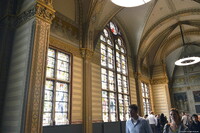Rijksmuseum
Cuypers, Petrus Josephus Hubertus; Cruz y Ortiz

Download1A2-N-A-RM-E02_cp.jpg (586.3Kb)
Alternate file
Date
1876-1885Description
Interior, the Voorhal (Great Hall) with stained glass windows by William Francis Dixon (British artist, ca. 1847-1928); center window representing Architecture; The Rijksmuseum (translation: State Museum) is the Dutch national museum for arts and history, first founded in 1800 in The Hague; it was moved to Amsterdam in 1808 under King Louis Napoleon. P.J.H. Cuypers is known as ‘the Dutch Viollet-le-Duc’ because he restored numerous medieval buildings and followed the French theorist’s principles of structural rationalism and geometric proportion; he could also be dubbed the Dutch William Morris because of his decisive role in revitalizing the arts and crafts in the Netherlands. For the Rijksmuseum commission (contest 1876), Cuypers created an influential national style by combining such medieval, Renaissance and Baroque motifs as pointed ribbed vaults, round-headed windows and mansard roofs, with modern materials such as iron and glass. The complex decorative program required the talents of a host of artists and artisans working in a variety of media, a consummate example of the 19th century ideal of the Gesamtkunstwerk. On 13 April 2013, after a ten-year renovation which cost € 375 million, the main building was reopened by Queen Beatrix. The restoration restored much of the original Cuypers interior, which had been altered over the years. Source: Grove Art Online; http://www.oxfordartonline.com/ (accessed 6/3/2014)
Type of Work
art museumSubject
architecture, decorative arts, Art museums, Revival styles, Nineteenth century, Renaissance Revival, Gothic Revival
Rights
Rights Statement
Licensed for educational and research use by the MIT community only